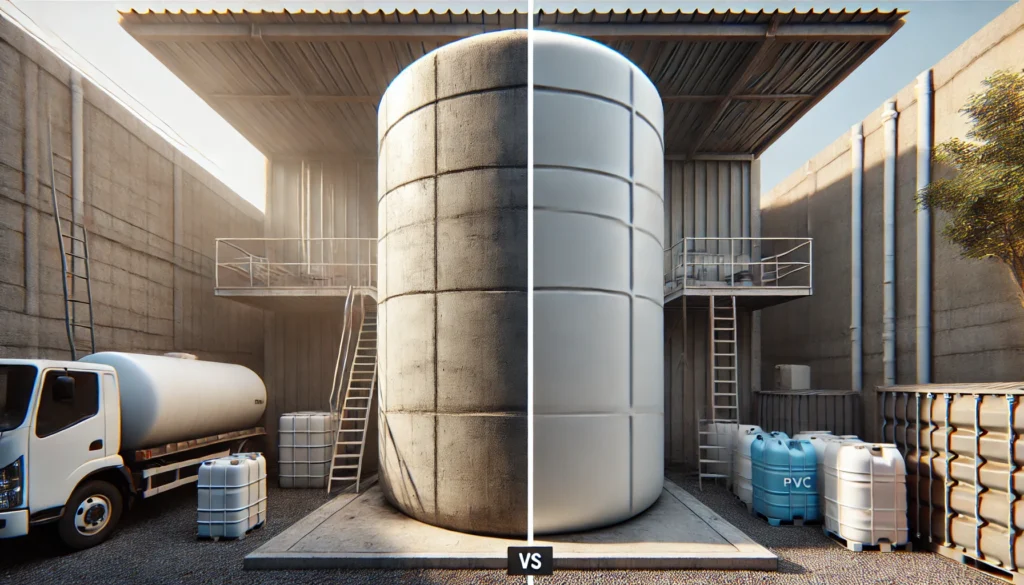Here are the key differences between concrete and PVC (Polyvinyl Chloride) water storage tanks:
1. Material Composition
- Concrete Tanks: Made from reinforced concrete, which is a mixture of cement, sand, aggregate, and steel reinforcements.
- PVC Tanks: Made from polyvinyl chloride (PVC), a type of plastic material, or polyethylene. These tanks are typically produced using a molding process.
2. Strength and Durability
- Concrete Tanks: Extremely strong and durable. They can withstand external forces such as soil pressure, vehicle loads, and harsh weather conditions. Concrete tanks have a very long lifespan, often lasting several decades.
- PVC Tanks: While durable for normal use, they are not as strong as concrete tanks. PVC tanks can be prone to damage from physical impact or extreme temperatures but are generally resistant to corrosion and rust.
3. Corrosion Resistance
- Concrete Tanks: Can be susceptible to corrosion, especially if exposed to chemicals or saltwater. Over time, concrete may develop cracks or be damaged by chemical reactions unless properly coated or lined.
- PVC Tanks: Naturally resistant to corrosion, rust, and chemicals, making them ideal for areas with corrosive environments or saline water. They do not require additional coatings.
4. Weight and Installation
- Concrete Tanks: Very heavy and require specialized equipment for transportation and installation. Installation is labor-intensive, involving site preparation, formwork, and curing time for the concrete.
- PVC Tanks: Lightweight and easy to transport and install. PVC tanks can be quickly installed without the need for heavy machinery, making them more practical for small installations or areas with limited access.
5. Maintenance
- Concrete Tanks: Require periodic maintenance, especially to check for cracks or leaks. Repairing concrete tanks can be labor-intensive and costly, particularly if they are buried or integrated into a structure.
- PVC Tanks: Require minimal maintenance. Occasional cleaning and checking for physical damage are usually sufficient. Repairs, when needed, are often easier and less expensive compared to concrete tanks.
6. Cost
- Concrete Tanks: Generally more expensive due to the cost of materials, labor, and installation. However, they offer long-term durability and are often seen as a long-term investment.
- PVC Tanks: More affordable upfront, both in terms of material cost and installation. However, they may have a shorter lifespan depending on the usage and environmental conditions.
7. Capacity and Size
- Concrete Tanks: Can be designed for very large capacities, making them suitable for industrial, municipal, and large agricultural water storage needs. They can also be built underground.
- PVC Tanks: Typically used for small to medium capacities. While they can be scaled up, they are generally limited in size compared to concrete tanks.
8. Flexibility and Customization
- Concrete Tanks: Can be custom-built to any shape and size, making them highly flexible for various applications. They can be designed for above-ground or underground use.
- PVC Tanks: Come in pre-molded shapes and sizes, which limits their customization options. They are typically cylindrical or rectangular in design.
9. Lifespan
- Concrete Tanks: Can last 30-50 years or more, depending on maintenance and environmental conditions. However, they may require periodic repairs and waterproofing over time.
- PVC Tanks: Typically last 10-20 years, depending on the quality of the material and environmental factors like UV exposure. They are prone to aging from prolonged exposure to sunlight.
10. Water Quality
- Concrete Tanks: Over time, concrete tanks may leach lime or other substances into the water, potentially altering its pH and affecting water quality if not properly lined or treated.
- PVC Tanks: Typically do not affect the water quality, as they are non-reactive. However, they can be prone to algae growth if exposed to sunlight, requiring UV-stabilized versions or regular cleaning.
11. Temperature Resistance
- Concrete Tanks: Offer better insulation, helping to regulate water temperature and protect against extreme heat or cold. Concrete tanks are also less affected by thermal expansion and contraction.
- PVC Tanks: More susceptible to temperature changes, which can cause expansion or contraction. Extreme heat may soften the material, while extreme cold may make it brittle.
12. Environmental Impact
- Concrete Tanks: The production of concrete involves significant carbon emissions, making it less environmentally friendly. However, the long lifespan of concrete tanks can offset this over time.
- PVC Tanks: PVC is a type of plastic derived from petroleum, and its production also has environmental implications. PVC tanks are generally recyclable, but improper disposal can contribute to plastic waste.
Summary
- Concrete Tanks: Strong, durable, customizable, and suitable for large capacities, but expensive and labor-intensive to install. Require maintenance to prevent corrosion and leaks.
- PVC Tanks: Lightweight, affordable, easy to install, and resistant to corrosion. Suitable for smaller capacities and require minimal maintenance, but have a shorter lifespan and are more susceptible to physical damage.
The choice between a concrete or PVC water storage tank depends on the specific requirements of the project, such as size, budget, location, and the intended use of the stored water.


